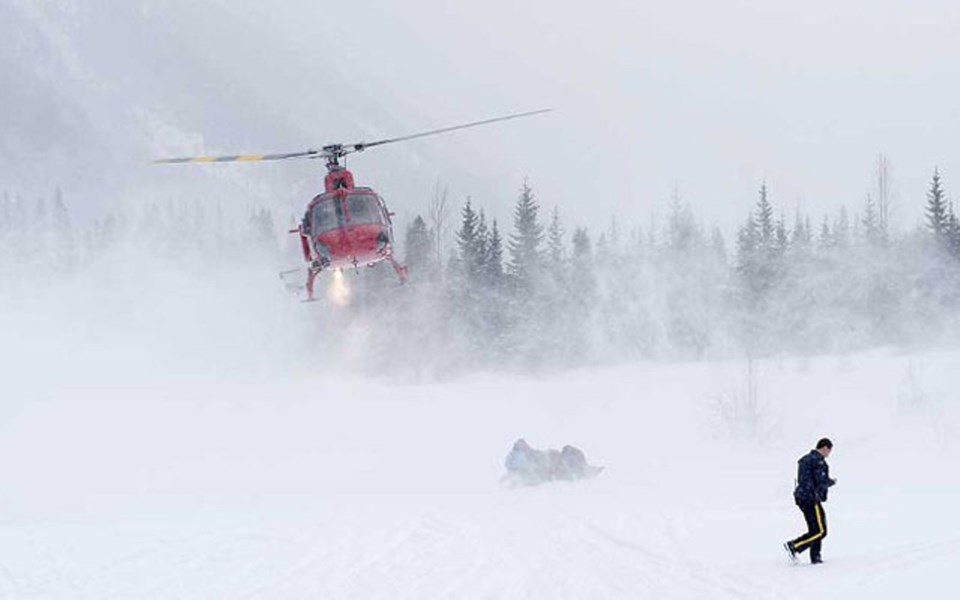Everyone is anxiously awaiting the first snowfall.
The Turkey Sale is over, new equipment is safely stored, waiting for the first taste of powder, and plans are being made.
But let's take a moment to inhale a deep breath and consider, as we should each year, how to enjoy the season safely.
It may seem early to consider this but the death this past weekend on Anniversary Glacier, near Pemberton, is a stark reminder of how things can go wrong even with planning and experience.
Michael Charles Low, 49, reportedly fell into a crevasse as he hiked. By all accounts he was an experienced hiker. He had told friends he planned to overnight Friday at the Keith Flavelle hut near the headwaters of Cerise Creek before returning Saturday afternoon to his Vancouver home.
But when he didn't show up to meet friends, search and rescue headed out, hoping for the best but fearing the worst had happened.
The location where Low's body was found was close to the site of another tragic incident from January where three hikers were killed after falling from a central couloir on Joffre Peak.
There is no doubt more and more people are heading out into the backcountry, and that is likely to continue as equipment improves along with training and a desire to actually be "in nature," as opposed to only enjoying in-bounds adventures.
But safely enjoying the backcountry is not just about equipment, nor is it just about proper safety training (though you must have that) — it is about both of these aspects and the human ability to make decisions.
Of the six factors (FACETS — familiarity, acceptance, consistency, experts, tracks/scarcity, and social facilitation) accepted as the decision-making model for avoiding avalanches and other risks, the one that should probably be on everyone's mind these days is scarcity (www.powder.com/stories/the-safe-zone/).
We have been snow-starved lately and it is not clear how this season will unfold, but now is not the time to get ready to feast without thought.
The sad passing of Mr. Low is a painful reminder as we get ready for the winter.
Though it may feel like more people are being injured in the backcountry, or maybe dying, in fact the opposite is true. While there is no way to measure the exact number of people heading out to enjoy nature, it has increased in double-digit percentages in the last decade, likely making the proportion of death to backcountry user head on the decline.
Obviously, even one death is one too many, and it remains true that the greatest asset to staying safe is knowledge — knowledge of terrain, of safety procedures, and of the abilities of all the other people you go into the great outdoors with.
But things can and do go wrong. The Sea to Sky is fortunate enough to have an incredible number of dedicated volunteers in its search and rescue teams from Squamish to Pemberton and beyond.
Each year these teams are put to the test, in some cases risking their own lives to save others. This past weekend the teams near Pemberton was called out three times to assist in rescues, or in the case of Mr. Low, a recovery.
In September, B.C.'s over-extended search and rescue groups asked the provincial government for a more stable cash source to alleviate some of the fundraising pressure on volunteers.
The BC Search and Rescue Association (BCSARA) has drawn up the Alternative Support Model to provide stable, long-term funding and support for ground search and rescue in the province.
"For many years our member groups have told us of the difficulties they have applying for grants and fundraising, and the huge amount of time and resources these tasks take," states the association's website. "This project has involved consultation and input from every one of the 80 Search and Rescue groups in B.C., and the current proposal is the result of this work."
It is hoped that by mid-December every one of B.C.'s SAR groups will have given feedback on the association's new funding model. From there, the input will be considered and the model updated where appropriate.
Then it will be sent to the province for consideration and discussion.
As part of the model it is hoped that a province will establish a foundation to support SAR teams and guarantee adequate annual funding for that foundation — perhaps using gambling proceeds.
According to the BCSARA proposal, the number of search and rescue missions in B.C. has risen to more than 1,300 a year, surging from just 900 in 2002 and 400 in 1991.
There is an expectation that rescuers will respond immediately whether it's to a lost hiker on Cypress Mountain or a lost skier in the backcountry of Duffey Lake Road.
And it's not just B.C. residents who rely on these SAR volunteers — all the visitors to resorts like Whistler rely on them too.
Much of the current funding for SAR teams depends on annual grant applications, which require serious effort from volunteers and don't result in a long-term source of income and local fundraising.
So as you head out on that hike this weekend, or plan your first backcountry trip when the snow flies, think ahead, be safe, let family and friends know your plan and let our SAR members enjoy an evening at home instead out searching the wilderness.




